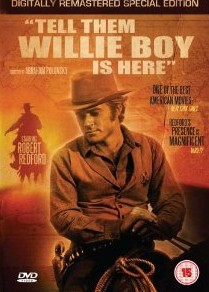- This essay will inevitably contain spoilers!
'TELL THEM WILLIE BOY IS HERE' (1969)

- A review by Richard Harrison (2011)
In films set in a specific historical era, about a specific historical
event, the relationship between what is shown in the film and what
actually took place is an intriguing one. Tell Them Willie Boy Is
Here , even before the Universal logo is seen, introduces, via a
caption which is also unnecessarily read to us, “an extraordinary
historical event” -in this case from 1909- and ‘this is what happened’.
Thus, a note of authenticity is struck even before the film has truly
begun, and it is one that does impact on the events that follow in a
film that is akin to a platter of buffet sandwiches- great to look at,
but far less interesting upon closer inspection.
One of the problems of a film claiming to narrate a true story is the
need to adhere to a set of pre-conceived events, which can mean the
material loses interest or outstays its welcome. This to some extent
applies to Tell Them Willie Boy Is Here , as Polonsky’s
direction is at times overly languid and unhurried. In its plot, Tell
Them Willie Boy Is Here has marked similarities to Terrence
Malick’s Badlands, released four years later in 1973, and
builds subconsciously on guy-and-girl-go-on-the-run movies which
include They Live By Night and Gun Crazy amongst
others. What Malick does in Badlands, by presenting characters
with psychological depth with whom we can relate, however bad their
actions, is not done by Polonsky in Tell Them Willie Boy Is Here .
Of the main characters, Deputy Sheriff Cooper (Robert Redford) is vapid
and colourless, Willie Boy himself (Robert Blake) dislikeable, though
he is still a more interesting character than Authority.
It is the opposition between Authority and Willie Boy which is at the
heart of Tell Them Willie Boy Is Here , but the discrimination
and prejudice shown the latter is a deeply questionable motivation for
his resulting deeds. Bizarrely, there are only two real instances where
Lola reveals her love for Willie Boy- both these occur beside water,
where the emotions overrun in moments of lyrical sensuality. The film
is unquestionably beautiful to look at- Conrad Hall’s experience as
cinematographer (his career included Butch Cassidy and the Sundance
Kid and American Beauty amongst others) a crucial factor in
the visual “look”. It is this, and pretty much this alone, that engages
the interest as the chase becomes increasingly less exciting due to
Polonsky’s self-indulgent direction. It is unfortunate, therefore, that
the film climaxes in a note of risible and clichéd
you-could-see-this-coming-a-mile-off predictability, which lessens much
of the limited impact of what has gone before.
In short, a film like Tell Them Willie Boy Is Here is one of
unfortunately unsympathetic performances- only Katharine Ross (with her
occasional outbursts of affection for Willie Boy) and Robert Lipton (as
Charlie Newcombe, the voice of reason, a character swiftly marginalised
in favour of other far less interesting ones) stand out. To return to
my sandwich analogy- the constituent elements need not be dull, it is
what is done with them that dictates that. The main problem with Tell
Them Willie Boy Is Here is that there is not enough filling to
make the cinematic sandwich a satisfying one, and, like the
aforementioned platter, the film ultimately outstays its welcome.
If the savoury side of Tell Them Willie Boy Is Here is not
sufficiently interesting, Odeon Entertainment has provided a wealth of
extras which do make this release worth acquiring, particularly for the
fan of Robert Redford- The Outlaw Trail (1978) and a South
Bank Show special about Redford’s Sundance Film Festival are
accompanied by a stills gallery and theatrical trailer.
Tell Them Willie Boy Is Here is available on DVD
from Odeon Entertainment.
Back
Home

